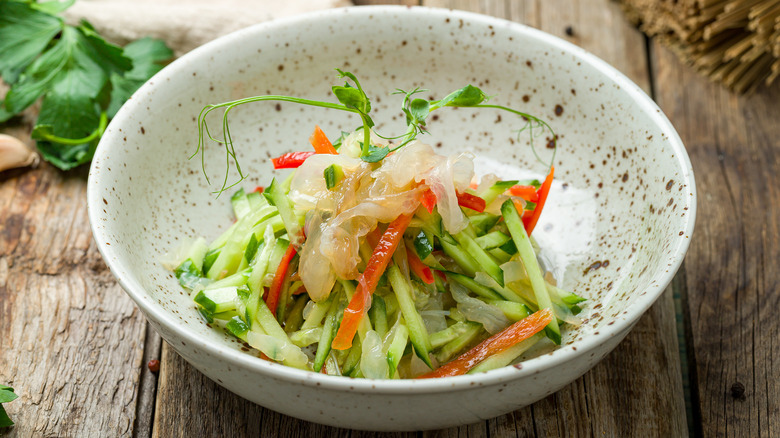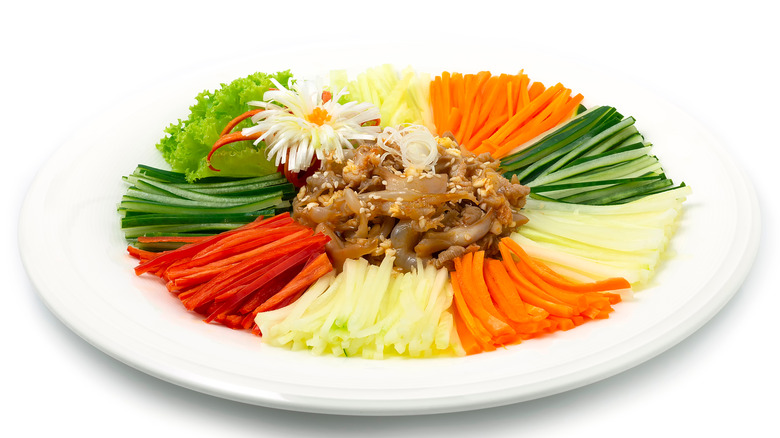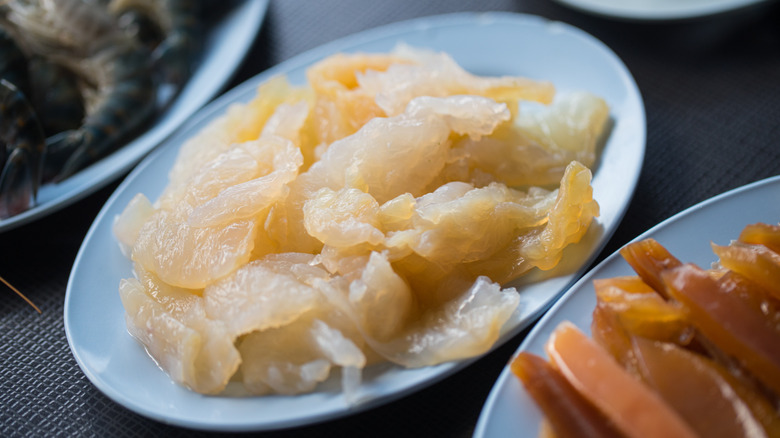What Is Jellyfish Salad And What's In It?
Jellyfish salad is a crunchy, flavorful, and refreshing appetizer popular in some Asian cuisines, and a culinary delight in countries such as China, Japan, Vietnam, and Korea. Although not a commonly served protein in the West, jellyfish have been a big part of Chinese cuisine for thousands of years. Jellyfish, which doesn't contain much flavor, is eaten more for its unique and satisfying texture — crunchy, chewy, or rubbery (like squid) depending on how it's prepared. It's the perfect blank canvas for absorbing sauces like sesame oil and soy sauce and pairs perfectly with crunchy vegetables. Certain edible species of jellyfish are also touted for their nutritional benefits as a low-fat, low-calorie, protein-rich, and collagen-rich food.
There are many variations of jellyfish salad but typical ingredient options include salted or shredded jellyfish, fresh veggies, fruits like Asian pears, sesame oil or vinaigrette, sesame seeds, crushed peanuts, and sometimes imitation crab or shrimp. While jellyfish is pretty bland and colorless, the vegetables and other ingredients are vibrant in color, resulting in an appetizer or side that is just as beautiful as it is delicious. If cooking or preparing raw jellyfish sounds daunting, don't worry because there are ready-to-eat versions that make putting together your salad super easy.
Yummy ingredients for this refreshing salad
Korean jellyfish salad (haepari-naengchae) is a colorful, crunchy, cold, and revitalizing side dish often served at parties and buffets. Its presentation quality is hard to beat — the vibrant ingredients are spread out in a circle around the salted jellyfish, resulting in a plate that looks like a radiant (not to mention mouthwatering) piece of art. The colorful circle includes ingredients sliced into thin sticks like cucumber, bell pepper, imitation crab, crisp Asian pear, and jidan (egg strips). The entire dish is covered in a spicy mustard vinaigrette that includes ingredients like mustard seed powder, vinegar, sesame oil, soy sauce, and garlic. The salad is traditionally served with the ingredients in bunches encircling the jellyfish so that people can choose what they want and essentially create their own salad. However, you can also mix it together and top it with some scallion curls for a different, yet still gorgeous presentation.
Another version of jellyfish salad, commonly referred to as Chinese-style jellyfish salad, is equally as tasty and incorporates more sesame flavor. Sesame jellyfish salad typically consists of ready-to-eat jellyfish mixed with fragrant and flavorful ingredients like garlic, green onion, ginger, and cilantro. The dressing packs an umami punch, often including sesame oil, soy sauce, and vinegar. To turn up the heat, add a dash or two of chili oil and/or some Sichuan peppercorns. This salad is commonly garnished with toasted sesame seeds to add some nutty flavor and extra crunchiness.
Buying and preparing the jellyfish
Ready-to-eat or instant jellyfish can be found in the refrigerated section of many Chinese and Korean grocery stores. It's typically packaged, shredded, and either brined or salted for preservation. When making jellyfish salad, it's advised to first rinse the salt off the jellyfish and then soak it in cold water for an hour or so to improve its taste and texture. After soaking it, pour the jellyfish shreds into a colander to drain the cold water. For a crunchier, more satisfying texture, pour boiling water over the jellyfish and drain immediately. Instant or ready-to-eat jellyfish doesn't need to be cooked so make sure not to leave it soaking in boiling water too long.
After absorbing the remaining moisture with a paper towel or a dish towel, you can cut the jellyfish strands with kitchen scissors to make it easier to eat. Add some sugar, salt, and vinegar, or marinate with sesame/chili oil and refrigerate until you're ready to serve the salad. The longer you marinate it, the more flavorful it will taste. Any leftovers should be refrigerated and eaten within a couple of days.


